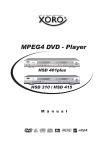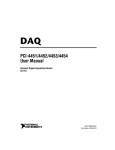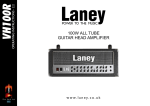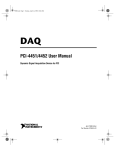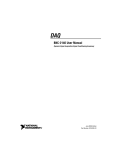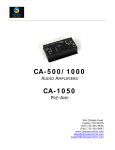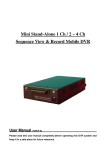Download National Instruments BNC-2140 Network Card User Manual
Transcript
UM.book Page 1 Tuesday, July 14, 1998 10:37 AM DAQ BNC-2140 User Manual Dynamic Signal Acquisition Signal Conditioning Accessory BNC-2140 User Manual June 1998 Edition Part Number 321933B-01 UM.book Page 2 Tuesday, July 14, 1998 10:37 AM Internet Support E-mail: [email protected] FTP Site: ftp.natinst.com Web Address: http://www.natinst.com Bulletin Board Support BBS United States: 512 794 5422 BBS United Kingdom: 01635 551422 BBS France: 01 48 65 15 59 Fax-on-Demand Support 512 418 1111 Telephone Support (USA) Tel: 512 795 8248 Fax: 512 794 5678 International Offices Australia 03 9879 5166, Austria 0662 45 79 90 0, Belgium 02 757 00 20, Brazil 011 288 3336, Canada (Ontario) 905 785 0085, Canada (Québec) 514 694 8521, Denmark 45 76 26 00, Finland 09 725 725 11, France 01 48 14 24 24, Germany 089 741 31 30, Hong Kong 2645 3186, Israel 03 6120092, Italy 02 413091, Japan 03 5472 2970, Korea 02 596 7456, Mexico 5 520 2635, Netherlands 0348 433466, Norway 32 84 84 00, Singapore 2265886, Spain 91 640 0085, Sweden 08 730 49 70, Switzerland 056 200 51 51, Taiwan 02 377 1200, United Kingdom 01635 523545 National Instruments Corporate Headquarters 6504 Bridge Point Parkway Austin, Texas 78730-5039 USA Tel: 512 794 0100 © Copyright 1998 National Instruments Corporation. All rights reserved. UM.book Page 3 Tuesday, July 14, 1998 10:37 AM Important Information Warranty The BNC-2140 is warranted against defects in materials and workmanship for a period of one year from the date of shipment, as evidenced by receipts or other documentation. National Instruments will, at its option, repair or replace equipment that proves to be defective during the warranty period. This warranty includes parts and labor. A Return Material Authorization (RMA) number must be obtained from the factory and clearly marked on the outside of the package before any equipment will be accepted for warranty work. National Instruments will pay the shipping costs of returning to the owner parts which are covered by warranty. National Instruments believes that the information in this manual is accurate. The document has been carefully reviewed for technical accuracy. In the event that technical or typographical errors exist, National Instruments reserves the right to make changes to subsequent editions of this document without prior notice to holders of this edition. The reader should consult National Instruments if errors are suspected. In no event shall National Instruments be liable for any damages arising out of or related to this document or the information contained in it. EXCEPT AS SPECIFIED HEREIN, NATIONAL INSTRUMENTS MAKES NO WARRANTIES, EXPRESS OR IMPLIED, AND SPECIFICALLY DISCLAIMS ANY WARRANTY OF MERCHANTABILITY OR FITNESS FOR A PARTICULAR PURPOSE. CUSTOMER’S RIGHT TO RECOVER DAMAGES CAUSED BY FAULT OR NEGLIGENCE ON THE PART OF NATIONAL INSTRUMENTS SHALL BE LIMITED TO THE AMOUNT THERETOFORE PAID BY THE CUSTOMER. NATIONAL INSTRUMENTS WILL NOT BE LIABLE FOR DAMAGES RESULTING FROM LOSS OF DATA, PROFITS, USE OF PRODUCTS, OR INCIDENTAL OR CONSEQUENTIAL DAMAGES, EVEN IF ADVISED OF THE POSSIBILITY THEREOF. This limitation of the liability of National Instruments will apply regardless of the form of action, whether in contract or tort, including negligence. Any action against National Instruments must be brought within one year after the cause of action accrues. National Instruments shall not be liable for any delay in performance due to causes beyond its reasonable control. The warranty provided herein does not cover damages, defects, malfunctions, or service failures caused by owner’s failure to follow the National Instruments installation, operation, or maintenance instructions; owner’s modification of the product; owner’s abuse, misuse, or negligent acts; and power failure or surges, fire, flood, accident, actions of third parties, or other events outside reasonable control. Copyright Under the copyright laws, this publication may not be reproduced or transmitted in any form, electronic or mechanical, including photocopying, recording, storing in an information retrieval system, or translating, in whole or in part, without the prior written consent of National Instruments Corporation. Trademarks ICP® is a registered trademark of PCB Piezotronics, Inc. Product and company names listed are trademarks or trade names of their respective companies. WARNING REGARDING MEDICAL AND CLINICAL USE OF NATIONAL INSTRUMENTS PRODUCTS National Instruments products are not designed with components and testing intended to ensure a level of reliability suitable for use in treatment and diagnosis of humans. Applications of National Instruments products involving medical or clinical treatment can create a potential for accidental injury caused by product failure, or by errors on the part of the user or application designer. Any use or application of National Instruments products for or involving medical or clinical treatment must be performed by properly trained and qualified medical personnel, and all traditional medical safeguards, equipment, and procedures that are appropriate in the particular situation to prevent serious injury or death should always continue to be used when National Instruments products are being used. National Instruments products are NOT intended to be a substitute for any form of established process, procedure, or equipment used to monitor or safeguard human health and safety in medical or clinical treatment. UM.book Page v Tuesday, July 14, 1998 10:37 AM Contents About This Manual Organization of This Manual .........................................................................................vii Conventions Used in This Manual.................................................................................viii Related Documentation..................................................................................................viii Customer Communication .............................................................................................viii Chapter 1 Introduction What You Need to Get Started ......................................................................................1-2 Unpacking ......................................................................................................................1-2 Optional Equipment .......................................................................................................1-2 Custom Cabling .............................................................................................................1-3 Chapter 2 Installation and Configuration Installation .....................................................................................................................2-1 Device Configuration.....................................................................................................2-1 Chapter 3 Signal Connections I/O Connectors ...............................................................................................................3-1 Analog Input Signal Connections ..................................................................................3-5 Analog Output Signal Connections ...............................................................................3-5 Chapter 4 Theory of Operation Functional Overview......................................................................................................4-2 Analog Input Circuitry...................................................................................................4-3 Analog Output................................................................................................................4-4 Appendix A Specifications Analog Input....................................................................................................A-1 Voltage Input.....................................................................................A-1 Current Excitation .............................................................................A-1 Analog Output .................................................................................................A-2 © National Instruments Corporation v BNC-2140 User Manual UM.book Page vi Tuesday, July 14, 1998 10:37 AM Contents Power Requirement (from DSA board) .......................................................... A-2 Physical ........................................................................................................... A-2 Environment.................................................................................................... A-2 Appendix B Customer Communication Glossary Index Figures Figure 2-1. Switch Settings and Signal Connections............................................... 2-2 Figure 3-1. BNC-2140 External 68-Pin Analog Connector .................................... 3-3 Figure 4-1. BNC-2140 Block Diagram ................................................................... 4-2 Tables Table 3-1. Table 3-2. BNC-2140 User Manual BNC Analog I/O Connector Signal Descriptions ................................ 3-1 68-Pin Analog I/O Connector Signal Descriptions .............................. 3-4 vi © National Instruments Corporation UM.book Page vii Tuesday, July 14, 1998 10:37 AM About This Manual This manual describes the electrical and mechanical aspects of the BNC-2140 accessory and contains information concerning its operation. Organization of This Manual The BNC-2140 User Manual is organized as follows: • Chapter 1, Introduction, describes the BNC-2140 accessory, lists what you need to get started, explains how to unpack your BNC-2140, and describes optional equipment. • Chapter 2, Installation and Configuration, explains how to install and configure your BNC-2140 accessory. • Chapter 3, Signal Connections, describes how to make input and output signal connections to your BNC-2140. • Chapter 4, Theory of Operation, contains a functional overview of the BNC-2140. • Appendix A, Specifications, lists the specifications of the BNC-2140. • Appendix B, Customer Communication, contains forms you can use to request help from National Instruments or to comment on our products and manuals. • The Glossary contains an alphabetical list and description of terms used in this manual, including abbreviations, acronyms, metric prefixes, mnemonics, and symbols. • The Index contains an alphabetical list of key terms and topics in this manual, including the page where you can find each one. © National Instruments Corporation vii BNC-2140 User Manual UM.book Page viii Tuesday, July 14, 1998 10:37 AM About This Manual Conventions Used in This Manual The following conventions are used in this manual: <> Angle brackets containing numbers separated by an ellipsis represent a range of values associated with a bit or signal name—for example, DIO<3..0>. This icon to the left of bold italicized text denotes a note, which alerts you to important information. ! This icon to the left of bold italicized text denotes a caution, which advises you of precautions to take to avoid injury, data loss, or a system crash. bold italic Bold italic text denotes a note or caution. italic Italic text denotes a variable, emphasis, a cross reference, or an introduction to a key concept. SE SE means referenced single ended (RSE). Related Documentation The following documents contain information you may find helpful: • National Instruments Application Note 025, Field Wiring and Noise Considerations for Analog Signals • PCI-4451/4452 User Manual • NI 4551/4552 User Manual Customer Communication National Instruments wants to receive your comments on our products and manuals. We are interested in the applications you develop with our products, and we want to help if you have problems with them. To make it easy for you to contact us, this manual contains comment and configuration forms for you to complete. These forms are in Appendix B, Customer Communication, at the end of this manual. BNC-2140 User Manual viii © National Instruments Corporation UM.book Page 1 Tuesday, July 14, 1998 10:37 AM 1 Introduction This chapter describes the BNC-2140 accessory, lists what you need to get started, explains how to unpack your BNC-2140, and describes optional equipment. Thank you for buying the BNC-2140 accessory for DSA.The BNC-2140 is a signal conditioning accessory specifically designed for use with a dynamic signal acquisition (DSA) series device. It interfaces four BNC signal inputs and two BNC signal outputs directly to National Instruments DSA products including the PCI-4451, PCI-4452, NI 4551, and NI 4552. The BNC-2140 connects to Integrated Circuit Piezoelectric (ICP®) accelerometers and microphone preamplifiers as well as any other voltage source whose output is less than ±42.4 V. Each input channel consists of an independent 4 mA current source suitable for use with ICP type accelerometers and microphone preamplifiers. You can manually enable or disable the ICP signal conditioning on a per channel basis. When disabled, the BNC-2140 acts as a direct voltage input. You can manually switch each input channel and each output channel from differential (DIFF) to single-ended (SE) mode. In SE mode, the BNC shell tethers to a clean analog ground through a 50 Ω resistor. The BNC-2140 receives power for the ICP signal conditioning from the DSA plug-in board via the 68-pin high-density connector. A green LED indicates when the ICP circuitry is powered on. When you do not require ICP signal conditioning, you can manually turn off the power to the circuits. © National Instruments Corporation 1-1 BNC-2140 User Manual UM.book Page 2 Tuesday, July 14, 1998 10:37 AM Chapter 1 Introduction What You Need to Get Started To set up and use your BNC-2140 device, you will need the following: ❑ BNC-2140 ❑ One of the following DSA devices: PCI-4451 PCI-4452 NI 4551 NI 4552 ❑ BNC-2140 User Manual ❑ Your computer ❑ SHC68-C68-A1 analog cable Unpacking Your BNC-2140 is shipped in an antistatic plastic package to prevent electrostatic damage to the device. Several components on the device can be damaged by electrostatic discharge. To avoid such damage in handling the device, take the following precautions: • Ground yourself via a grounding strap or by holding a grounded object. • Touch the plastic package to a metal part of your computer chassis before removing the device from the package. • Remove the device from the package and inspect the device for loose components or any other sign of damage. Notify National Instruments if the device appears damaged in any way. Do not install a damaged device. • Never touch the exposed pins of connectors. Optional Equipment If your application requires that you use transducers with microdot connectors, use the BNC plug screw-on receptacle, part number 033-0101-0001, from Microdot Connector Company. This accessory allows you to conect BNC and microdot connectors. BNC-2140 User Manual 1-2 © National Instruments Corporation UM.book Page 3 Tuesday, July 14, 1998 10:37 AM Chapter 1 Introduction If your application requires that you use a prepolarized microphone with a microphone preamplifier, contact Brüel and Kjær. Custom Cabling National Instruments offers cables of different lengths for the BNC-2140 accessory to connect your analog I/O signals to the DSA devices. National Instruments recommends that you not develop your own cabling solution due to the high-density connector that is required and the necessity to maintain high signal integrity. If your application requires you to develop your own cable, use the following guidelines: • Use shielded twisted-pair wires for each differential analog input or output channel pair. Since the signals are differential, using this type of wire yields the best results. • When connecting the cable shields, be sure to connect the analog input grounds to the AIGND pins and the analog output grounds to the AOGND pins. For a connector pinout description refer to Table 3-2 in Chapter 3, Signal Connections. • You can create your own accessories by using a 68-pin very high density cable interconnect (VHDCI) receptacle header using AMP 68-position right-angle PWB receptacle header 787254-1. • Recommended manufacturer part numbers for the 68-pin mating connector (for the cable assembly) are as follows: © National Instruments Corporation – AMP 68-position cable straight plug, part number 787131-3 – AMP 68-position backshell with jackscrews, part number 787191-1 1-3 BNC-2140 User Manual UM.book Page 1 Tuesday, July 14, 1998 10:37 AM Installation and Configuration 2 This chapter explains how to install and configure your BNC-2140 accessory. Installation Note You must turn the power off to your computer before installing the BNC-2140. The following are general installation instructions. 1. Insert either end of your SHC68-C68-A1 analog cable into the 68-pin connector on the BNC-2140. Insert the other end into the 68-pin connector on the DSA plug-in device. 2. Tighten the jack screws finger-tight on both ends of the cable. 3. Check the installation. 4. Turn on your computer. The BNC-2140 accessory is now installed. Device Configuration You must manually configure the BNC-2140 accessory by setting the channel switches. You can configure each input channel to have ICP signal conditioning enabled or disabled, and for DIFF and SE measurements. You can also configure each output channel for DIFF or SE measurements. You can turn the power on or off for the ICP signal conditioning circuitry. If you do not require ICP signal conditioning, turn off the ICP power. Refer to Figure 2-1 for the location of the switches. Note You can connect or disconnect BNC cables carrying signals without turning off the computer. © National Instruments Corporation 2-1 BNC-2140 User Manual UM.book Page 2 Tuesday, July 14, 1998 10:37 AM Chapter 2 Installation and Configuration ® Figure 2-1. Switch Settings and Signal Connections BNC-2140 User Manual 2-2 © National Instruments Corporation UM.book Page 1 Tuesday, July 14, 1998 10:37 AM 3 Signal Connections This chapter describes how to connect input and output signals to your BNC-2140. You can connect the external analog signals through six BNC connectors. Four BNC connectors are for input signals and two connectors are for output signals. The SHC68-C68-A1 shielded cable connects the BNC-2140 internal analog signal connector to the DSA plug-in device. A single 68-pin 0.8 mm VHDCI connector connects the analog I/O signals to the shielded cable. I/O Connectors Table 3-1 shows the pin assignments for the six external I/O BNC connectors. Table 3-1. BNC Analog I/O Connector Signal Descriptions Signal Name Reference Direction Description +ACH<0..3> AIGND Input +Analog Input Channel 0 through 3—Each channel can have ICP enabled or disabled. This signal passes through the BNC internal conductor. –ACH<0..3> AIGND Input –Analog Input Channel 0 through 3—In SE mode the inverting (–) terminal is tethered to ground through a 50 Ω resistor. This signal passes through the external BNC shell. +DAC0OUT –DAC0OUT Output +Analog Output Channel 0—This pin supplies the analog non-inverting output channel 0. This signal passes through the internal BNC conductor. –DAC0OUT +DAC0OUT Output –Analog Output Channel 0—This pin supplies the analog inverting output channel 0. This signal passes through the external BNC shell. In SE mode, the inverting (–) terminal is tethered to ground through a 50 Ω resistor. © National Instruments Corporation 3-1 BNC-2140 User Manual UM.book Page 2 Tuesday, July 14, 1998 10:37 AM Chapter 3 Signal Connections Table 3-1. BNC Analog I/O Connector Signal Descriptions (Continued) Signal Name Reference +DAC1OUT –DAC1OUT Output +Analog Output Channel 1—This pin supplies the analog non-inverting output channel 1. This signal passes through the internal BNC conductor. –DAC1OUT +DAC1OUT Output –Analog Output Channel 1—This pin supplies the analog inverting output channel 1. This signal passes through the external BNC shell. In SE mode, the inverting (–) terminal is tethered to ground through a 50 Ω resistor. BNC-2140 User Manual Direction Description 3-2 © National Instruments Corporation UM.book Page 3 Tuesday, July 14, 1998 10:37 AM Chapter 3 Signal Connections Figure 3-1 describes the pin connections on the BNC-2140 68-pin connector. –ACH0 † AIGND –ACH1 † AIGND –ACH2 † AIGND –ACH3 † AIGND NC NC NC NC NC NC NC NC NC NC NC NC NC NC NC NC –DAC0OUT † AOGND –DAC1OUT † AOGND NC NC NC NC +5 V DGND 1 2 3 4 5 6 7 8 9 10 11 12 13 14 15 16 17 18 19 20 21 22 23 24 25 26 27 28 29 30 31 32 33 34 35 36 37 38 39 40 41 42 43 44 45 46 47 48 49 50 51 52 53 54 55 56 57 58 59 60 61 62 63 64 65 66 67 68 +ACH0 AIGND +ACH1 AIGND +ACH2 AIGND +ACH3 AIGND NC NC NC NC NC NC NC NC NC NC NC NC NC NC NC NC +DAC0OUT AOGND +DAC1OUT AOGND NC NC NC NC +5 V DGND † These AIGND and AOGND pins are not connected in the SHC6868-A1 cable Figure 3-1. BNC-2140 External 68-Pin Analog Connector © National Instruments Corporation 3-3 BNC-2140 User Manual UM.book Page 4 Tuesday, July 14, 1998 10:37 AM Chapter 3 Signal Connections Note This BNC-2140 pin assignment maps to the pin assignment of the DSA device you are connecting to the BNC-2140. Refer to your DSA device user manual for the pin assignments specific to your device connection. Table 3-2 shows the pin assignments for the internal 68-pin I/O connector. Table 3-2. 68-Pin Analog I/O Connector Signal Descriptions Signal Name AIGND Reference Direction Description — — Analog Input Ground—These pins are the reference point for single-ended measurements in SE mode and the bias current return point for differential measurements. +ACH<0..3> AIGND Input +Analog Input Channel 0 through 3. –ACH<0..3> AIGND Input –Analog Input Channel 0 through 3. +DAC0OUT –DAC0OUT Output +Analog Output Channel 0. –DAC0OUT +DAC0OUT Output –Analog Output Channel 0. +DAC1OUT –DAC1OUT Output +Analog Output Channel 1. –DAC1OUT +DAC1OUT Output –Analog Output Channel 1. AOGND — — Analog Output Ground—The analog output voltages are ultimately referenced to this node. DGND — — Digital Ground—This pin supplies the reference for the +5 VDC supply. +5 V DGND Output +5 VDC Source—These pins are fused for up to 0.5 A of +5 V supply on the DSA plug-in device. The fuse is self-resetting. This source powers the ICP circuits of the BNC-2140. NOTE: For +ACH<0..3>, –ACH<0..3>, +DAC0OUT, –DAC0OUT, +DAC1OUT, and –DAC1OUT descriptions see Table 3-1. Refer to Figure 3-1 for the pin assignments for the 68-pin connector. ! Caution Connections that exceed any of the maximum ratings of input or output signals on the BNC-2140 accessory can damage not only the BNC-2140, but also the DSA plug-in device and the computer as well. Maximum input ratings for each signal are given in Appendix A, Specifications. National Instruments is not liable for any damages resulting from signal connections exceeding maximum ratings. BNC-2140 User Manual 3-4 © National Instruments Corporation UM.book Page 5 Tuesday, July 14, 1998 10:37 AM Chapter 3 Signal Connections The outer shell of the BNC connectors is not GND (0 V). The outer shell of the BNC is not physically connected to the metal box of the BNC-2140. The outer shell is either the inverting differential signal in DIFF mode or is tethered to GND (0 V) through a 50 Ω, 1 W resistor in SE mode. Analog Input Signal Connections The analog input signals for the BNC-2140 device are +ACH<0..3> and –ACH<0..3>. Connecting of analog input signals to your BNC-2140 accessory depends on the configuration of the input signal sources. For most signals, you use a DIFF configuration and simply connect the signal to +ACHx (where x is the BNC-2140 channel) and the signal ground (or signal minus), as appropriate, to –ACHx. If a signal has a high output impedance (greater than 1 kΩ) and is floating, you may find it useful to use an SE configuration that tethers the signal minus to AIGND. This reduces common-mode interference. Analog Output Signal Connections The BNC-2140 analog output signals are +DAC0OUT, –DAC0OUT, +DAC1OUT, and –DAC1OUT. +DAC0OUT is the voltage output signal for analog output channel 0. +DAC1OUT is the voltage output signal for analog output channel 1. Connection of analog output signals from your BNC-2140 accessory depends on the configuration of the devices receiving the signals. For most signals, you use a DIFF configuration and simply connect +DACxOUT (where x is the BNC-2140 channel) to the signal and –DACxOUT to the signal ground (or signal minus), as appropriate. When driving some floating devices, you may sometimes find it helpful to use the SE configuration and connect the floating ground system of the device to AOGND to reduce common-mode noise coupled from an interfering source to the device. ! Caution When you configure an analog output channel in the SE mode, the voltage between AOGND and –DACxOUT must not exceed ±7.07 V (5 Vrms). Voltage that exceeds this rating can damage the BNC-2140, the DSA plug-in device, and the computer. National Instruments is not responsible for any damages resulting from connections that exceed this rating. © National Instruments Corporation 3-5 BNC-2140 User Manual UM.book Page 1 Tuesday, July 14, 1998 10:37 AM 4 Theory of Operation This chapter contains a functional overview of the BNC-2140. © National Instruments Corporation 4-1 BNC-2140 User Manual UM.book Page 2 Tuesday, July 14, 1998 10:37 AM Chapter 4 Theory of Operation Functional Overview Figure 4-1 is a block diagram of the BNC-2140. 68-Pin Connector ICP CH0 Isolated Power Supply +5 V +30 V 0 ICP Enable on/off AICH0+ AICH0 BNC Connector 50 Ω ICP Current Source 0 ICP CH3 Isolated Power Supply +5 V DIFF/SE ICP Enable on/off AICH0– AIGND AICH3+ AICH3 BNC Connector +30 V 3 50 Ω ICP Current Source 3 DIFF/SE AICH3– AIGND DAC0OUT+ DAC0OUT BNC Connector 50 Ω DIFF/SE DAC0OUT– AOGND DAC1OUT+ DAC1OUT BNC Connector 50 Ω DIFF/SE DAC1OUT– AOGND +5 V ICP Power on/off +5 V DGND Figure 4-1. BNC-2140 Block Diagram BNC-2140 User Manual 4-2 © National Instruments Corporation UM.book Page 3 Tuesday, July 14, 1998 10:37 AM Chapter 4 Theory of Operation Analog Input Circuitry The BNC-2140 has four identical analog input channels. A principal function of the BNC-2140 is to supply a constant current for ICP type accelerometers and microphone preamplifiers. Many accelerometers use piezoelectric materials to generate a charge that is proportional to the acceleration applied. Although these types of accelerometers have certain advantages, they are very suseptable to external noise. ICP-type sensor manufacturers embed a charge amplifier within the transducer to reduce the effect of cable length, noise, and other spurious effects. The BNC-2140 supplies the constant current required to power that embedded charge amplyfier ICP that allows you to use inexpensive cables such as BNC cables. Leveraging off this technology, some manufacturers use ICP signal conditioning to power their prepolarized microphones. If your application requires a microphone preamplifier for use with a prepolarized microphone see Optional Equipment, in Chapter 1, for a list of recommended suppliers. You must enable ICP to generate the required power for each channel that uses these types of accelerometers and microphone preamplifiers. When you disable ICP, the connection from the ICP circuit to the analog input signal breaks and has no impact on the incoming signal. When you disable ICP on an input channel, the circuitry of two channels is still energized. If you do not require ICP to be enabled on any of the four input channels, turn off the ICP power to de-energize the circuitry. Turning off the ICP power removes any noise the circuitry can induce on the incoming signal. You can also use the BNC-2140 to select between DIFF and SE input modes. The BNC-2140 works with any DSA device that has a differential input stage for each input channel. In DIFF mode, one line connects to the positive input of the channel, and the other connects to the negative input of that same channel. You can connect the differential input to either floating or ground-referenced signals. You can use ICP signal conditioning when the BNC-2140 inputs are either in DIFF or SE mode. © National Instruments Corporation 4-3 BNC-2140 User Manual UM.book Page 4 Tuesday, July 14, 1998 10:37 AM Chapter 4 Theory of Operation Analog Output The BNC-2140 has two analog output channels. The BNC-2140 can also select between DIFF and SE outputs. In DIFF mode, one line connects to the positive output of the channel and the other connects to the negative output of that same channel. You can connect the differential output to either floating or ground-referenced signals. BNC-2140 User Manual 4-4 © National Instruments Corporation UM.book Page 1 Tuesday, July 14, 1998 10:37 AM A Specifications This appendix lists the specifications of the BNC-2140 accessory. All specifications are typical at 25° C unless otherwise noted. All specifications are relative to measurement standards and require a 15 minute warm-up period. Specifications do not include transducer error. Analog Input Voltage Input Number of channels ............................... 4 Maximum input voltage (Signal + common mode voltage).......... Each input should remain within ±42.4 V (30 Vrms) of any other input or of AIGND Inputs affected........................................ ACH0, ACH1, ACH2, ACH3 Input coupling ........................................ DC Input capacitance1 DIFF mode Current excitation on ............... 85 pF Current excitation off............... 75 pF SE mode Current excitation on ............... 150 pF Current excitation off............... 145 pF Current Excitation Level....................................................... 4 mA Accuracy ................................................ ±1.31% 1 Includes the effects of the BNC-2140 with a 1 m SHC68-C68-A1 analog cable © National Instruments Corporation A-1 BNC-2140 User Manual UM.book Page 2 Tuesday, July 14, 1998 10:37 AM Appendix A Specifications Temperature coefficient..........................±141 ppm/° C Voltage compliance ................................24 V Excitation overvoltage protection...........±42.4 V (30 Vrms) powered on or off Analog Output Number of channels................................2, see Caution under Analog Output Signal Connections, in Chapter 3, Signal Connections Output coupling ......................................DC Power Requirement (from DSA board) Power consumption ................................400 mA at +5 VDC Physical Dimensions .............................................14.0 by 11.2 by 3.8 cm (6.0 by 4.4 by 1.6 in.) I/O connectors I/O Signals .......................................6 BNC connectors (outer shell isolated from box metal) DSA board connection ....................68-pin 0.8 mm VHDCI female connector Environment Operating temperature ............................0° to 40° C Storage temperature ................................–55° to 150° C Relative humidity ...................................5% to 90% non-condensing BNC-2140 User Manual A-2 © National Instruments Corporation UM.book Page 1 Tuesday, July 14, 1998 10:37 AM Customer Communication B For your convenience, this appendix contains forms to help you gather the information necessary to help us solve your technical problems and a form you can use to comment on the product documentation. When you contact us, we need the information on the Technical Support Form and the configuration form, if your manual contains one, about your system configuration to answer your questions as quickly as possible. National Instruments has technical assistance through electronic, fax, and telephone systems to quickly provide the information you need. Our electronic services include a bulletin board service, an FTP site, a fax-on-demand system, and e-mail support. If you have a hardware or software problem, first try the electronic support systems. If the information available on these systems does not answer your questions, we offer fax and telephone support through our technical support centers, which are staffed by applications engineers. Electronic Services Bulletin Board Support National Instruments has BBS and FTP sites dedicated for 24-hour support with a collection of files and documents to answer most common customer questions. From these sites, you can also download the latest instrument drivers, updates, and example programs. For recorded instructions on how to use the bulletin board and FTP services and for BBS automated information, call 512 795 6990. You can access these services at: United States: 512 794 5422 Up to 14,400 baud, 8 data bits, 1 stop bit, no parity United Kingdom: 01635 551422 Up to 9,600 baud, 8 data bits, 1 stop bit, no parity France: 01 48 65 15 59 Up to 9,600 baud, 8 data bits, 1 stop bit, no parity FTP Support To access our FTP site, log on to our Internet host, ftp.natinst.com, as anonymous and use your Internet address, such as [email protected], as your password. The support files and documents are located in the /support directories. © National Instruments Corporation B-1 BNC-2140 User Manual UM.book Page 2 Tuesday, July 14, 1998 10:37 AM Fax-on-Demand Support Fax-on-Demand is a 24-hour information retrieval system containing a library of documents on a wide range of technical information. You can access Fax-on-Demand from a touch-tone telephone at 512 418 1111. E-Mail Support (Currently USA Only) You can submit technical support questions to the applications engineering team through e-mail at the Internet address listed below. Remember to include your name, address, and phone number so we can contact you with solutions and suggestions. [email protected] Telephone and Fax Support National Instruments has branch offices all over the world. Use the list below to find the technical support number for your country. If there is no National Instruments office in your country, contact the source from which you purchased your software to obtain support. Country Telephone Fax Australia Austria Belgium Brazil Canada (Ontario) Canada (Québec) Denmark Finland France Germany Hong Kong Israel Italy Japan Korea Mexico Netherlands Norway Singapore Spain Sweden Switzerland Taiwan United Kingdom United States 03 9879 5166 0662 45 79 90 0 02 757 00 20 011 288 3336 905 785 0085 514 694 8521 45 76 26 00 09 725 725 11 01 48 14 24 24 089 741 31 30 2645 3186 03 6120092 02 413091 03 5472 2970 02 596 7456 5 520 2635 0348 433466 32 84 84 00 2265886 91 640 0085 08 730 49 70 056 200 51 51 02 377 1200 01635 523545 512 795 8248 03 9879 6277 0662 45 79 90 19 02 757 03 11 011 288 8528 905 785 0086 514 694 4399 45 76 26 02 09 725 725 55 01 48 14 24 14 089 714 60 35 2686 8505 03 6120095 02 41309215 03 5472 2977 02 596 7455 5 520 3282 0348 430673 32 84 86 00 2265887 91 640 0533 08 730 43 70 056 200 51 55 02 737 4644 01635 523154 512 794 5678 BNC-2140 User Manual B-2 © National Instruments Corporation UM.book Page 3 Tuesday, July 14, 1998 10:37 AM Technical Support Form Photocopy this form and update it each time you make changes to your software or hardware, and use the completed copy of this form as a reference for your current configuration. Completing this form accurately before contacting National Instruments for technical support helps our applications engineers answer your questions more efficiently. If you are using any National Instruments hardware or software products related to this problem, include the configuration forms from their user manuals. Include additional pages if necessary. Name __________________________________________________________________________ Company _______________________________________________________________________ Address ________________________________________________________________________ _______________________________________________________________________________ Fax ( ___ ) ________________Phone ( ___ ) __________________________________________ Computer brand____________ Model ___________________ Processor_____________________ Operating system (include version number) ____________________________________________ Clock speed ______MHz RAM _____MB Mouse ___yes ___no Display adapter __________________________ Other adapters installed _______________________________________ Hard disk capacity _____MB Brand_________________________________________________ Instruments used _________________________________________________________________ _______________________________________________________________________________ National Instruments hardware product model _____________ Revision ____________________ Configuration ___________________________________________________________________ National Instruments software product ___________________ Version _____________________ Configuration ___________________________________________________________________ The problem is: __________________________________________________________________ _______________________________________________________________________________ _______________________________________________________________________________ _______________________________________________________________________________ _______________________________________________________________________________ List any error messages: ___________________________________________________________ _______________________________________________________________________________ _______________________________________________________________________________ The following steps reproduce the problem: ___________________________________________ _______________________________________________________________________________ _______________________________________________________________________________ _______________________________________________________________________________ _______________________________________________________________________________ UM.book Page 5 Tuesday, July 14, 1998 10:37 AM Documentation Comment Form National Instruments encourages you to comment on the documentation supplied with our products. This information helps us provide quality products to meet your needs. Title: BNC-2140 User Manual Edition Date: June 1998 Part Number: 321933B-01 Please comment on the completeness, clarity, and organization of the manual. _______________________________________________________________________________ _______________________________________________________________________________ _______________________________________________________________________________ _______________________________________________________________________________ _______________________________________________________________________________ _______________________________________________________________________________ _______________________________________________________________________________ If you find errors in the manual, please record the page numbers and describe the errors. _______________________________________________________________________________ _______________________________________________________________________________ _______________________________________________________________________________ _______________________________________________________________________________ _______________________________________________________________________________ _______________________________________________________________________________ _______________________________________________________________________________ Thank you for your help. Name _________________________________________________________________________ Title __________________________________________________________________________ Company _______________________________________________________________________ Address ________________________________________________________________________ _______________________________________________________________________________ E-Mail Address __________________________________________________________________ Phone ( ___ ) __________________________ Fax ( ___ ) _______________________________ Mail to: Technical Publications National Instruments Corporation 6504 Bridge Point Parkway Austin, Texas 78730-5039 Fax to: Technical Publications National Instruments Corporation 512 794 5678 UM.book Page 1 Tuesday, July 14, 1998 10:37 AM Glossary Prefix Meanings Value p- pico 10 –12 n- nano- 10 –9 µ- micro- 10 – 6 m- milli- 10 –3 k- kilo- 10 3 M- mega- 10 6 G- giga- 10 9 t- tera- 10 12 Numbers/Symbols % percent + positive of, or plus – negative of, or minus / per ° degree Ω ohm +5 V +5 V VDC source signal A A amperes AC alternating current AC coupled allowing the transmission of AC signals while blocking DC signals © National Instruments Corporation G-1 BNC-2140 User Manual UM.book Page 2 Tuesday, July 14, 1998 10:37 AM Glossary ACH analog input channel signal A/D analog-to-digital ADC analog-to-digital converter—an electronic device, often an integrated circuit, that converts an analog voltage to a digital number alias a false lower frequency component that appears in sampled data acquired at too low a sampling rate amplification a type of signal conditioning that improves accuracy in the resulting digitized signal and reduces noise amplitude flatness a measure of how close to constant the gain of a circuit remains over a range of frequencies AOGND analog output ground signal attenuate to decrease the amplitude of a signal attenuation ratio the factor by which a signal’s amplitude is decreased B b bit—one binary digit, either 0 or 1 B byte—eight related bits of data, an eight-bit binary number. Also used to denote the amount of memory required to store one byte of data. bandwidth the range of frequencies present in a signal, or the range of frequencies to which a measuring device can respond bipolar a signal range that includes both positive and negative values (for example, –5 V to +5 V) BNC a type of coaxial signal connector BNC-2140 User Manual G-2 © National Instruments Corporation UM.book Page 3 Tuesday, July 14, 1998 10:37 AM Glossary C C Celsius channel pin or wire lead to which you apply or from which you read the analog or digital signal. Analog signals can be single-ended or differential. For digital signals, you group channels to form ports. Ports usually consist of either four or eight digital channels. CMRR common-mode rejection ratio—a measure of an instrument’s ability to reject interference from a common-mode signal, usually expressed in decibels (dB) common-mode range the input range over which a circuit can handle a common-mode signal common-mode signal the mathematical average voltage, relative to the computer’s ground, of the signals from a differential input common-mode voltage any voltage present at the instrumentation amplifier inputs with respect to amplifier ground compensation range the range of a parameter for which compensating adjustment can be made conversion device device that transforms a signal from one form to another. For example, analog-to-digital converters (ADCs) for analog input, digital-to-analog converters (DACs) for analog output, digital input or output ports, and counter/timers are conversion devices. conversion time the time required, in an analog input or output system, from the moment a channel is interrogated (such as with a read instruction) to the moment that accurate data is available coupling the manner in which a signal is connected from one location to another crosstalk an unwanted signal on one channel due to an input on a different channel current drive capability the amount of current a digital or analog output channel is capable of sourcing or sinking while still operating within voltage range specifications current sinking the ability of a DAQ board to dissipate current for analog or digital output signals current sourcing the ability of a DAQ board to supply current for analog or digital output signals © National Instruments Corporation G-3 BNC-2140 User Manual UM.book Page 4 Tuesday, July 14, 1998 10:37 AM Glossary D D/A digital-to-analog DAC digital-to-analog converter—an electronic device, often an integrated circuit, that converts a digital number into a corresponding analog voltage or current DAC0OUT analog channel 0 output signal DAC1OUT analog channel 1output signal dB decibel—the unit for expressing a logarithmic measure of the ratio of two signal levels: dB=20log10 (V1/V2), for signals in volts DC direct current DC coupled allowing the transmission of both AC and DC signals default setting a default parameter value recorded in the driver. In many cases, the default input of a control is a certain value (often 0) that means use the current default setting. For example, the default input for a parameter may be do not change current setting, and the default setting may be no AMUX-64T boards. If you do change the value of such a parameter, the new value becomes the new setting. You can set default settings for some parameters in the configuration utility or manually using switches located on the device. delta-sigma modulating ADC a high-accuracy circuit that samples at a higher rate and lower resolution than is needed and (by means of feedback loops) pushes the quantization noise above the frequency range of interest. This out-of-band noise is typically removed by digital filters. DGND digital ground signal DIFF differential mode differential input an analog input consisting of two terminals, both of which are isolated from computer ground, whose difference is measured differential measurement a way you can configure your device to read signals, in which you do not system need to connect either input to a fixed reference, such as the earth or a building ground DIO BNC-2140 User Manual digital input/output G-4 © National Instruments Corporation UM.book Page 5 Tuesday, July 14, 1998 10:37 AM Glossary DNL differential nonlinearity—a measure in least significant bit of the worst-case deviation of code widths from their ideal value of 1 LSB dynamic range the ratio of the largest signal level a circuit can handle to the smallest signal level it can handle (usually taken to be the noise level), normally expressed in decibels E EMC electromechanical compliance F floating signal sources signal sources with voltage signals that are not connected to an absolute reference or system ground. Also called nonreferenced signal sources. Some common example of floating signal sources are batteries, transformers, or thermocouples. G gain the factor by which a signal is amplified, sometimes expressed in decibels gain accuracy a measure of deviation of the gain of an amplifier from the ideal gain grms level of random vibration grounded measurement system See SE. H h hour hardware the physical components of a computer system, such as the circuit boards, plug-in boards, chassis, enclosures, peripherals, and cables hex hexadecimal Hz hertz—cycles per second. Specifically refers to the repetition frequency of a waveform. © National Instruments Corporation G-5 BNC-2140 User Manual UM.book Page 6 Tuesday, July 14, 1998 10:37 AM Glossary I IC integrated circuit ICP Integrated Circuit Piezoelectric—identifies products that operate using a constant current source and returns the output signal in the form of voltage modulation on the same line as the constant current source. IMD intermodulation distortion—the ratio, in dB, of the total rms signal level of harmonic sum and difference distortion products, to the overall rms signal level. The test signal is two sine waves added together according to the following standards: SMPTE—A 60 Hz sine wave and a 7 kHz sine wave added in a 4:1 amplitude ratio. DIN—A 250 Hz sine wave and an 8 kHz sine wave added in a 4:1 amplitude ratio. CCIF—A 14 kHz sine wave and a 15 kHz sine wave added in a 1:1 amplitude ratio. in. inches INL integral nonlinearity—a measure in LSB of the worst-case deviation from the ideal A/D or D/A transfer characteristic of the analog I/O circuitry input bias current the current that flows into the inputs of a circuit input impedance the measured resistance and capacitance between the input terminals of a circuit input offset current the difference in the input bias currents of the two inputs of an instrumentation amplifier instrumentation amplifier a circuit whose output voltage with respect to ground is proportional to the difference between the voltages at its two inputs I/O input/output—the transfer of data to/from a computer system involving communications channels, operator interface devices, and/or data acquisition and control interfaces IOH current, output high IOL current, output low BNC-2140 User Manual G-6 © National Instruments Corporation UM.book Page 7 Tuesday, July 14, 1998 10:37 AM Glossary K k kilo—the standard metric prefix for 1,000, or 103, used with units of measure such as volts, hertz, and meters K kilo—the prefix for 1,024, or 210, used with B in quantifying data or computer memory kS 1,000 samples L LabVIEW laboratory virtual instrument engineering workbench linearity the adherence of device response to the equation R = KS, where R = response, S = stimulus, and K = a constant linearization a type of signal conditioning in which software linearizes the voltage levels from transducers, so the voltages can be scaled to measure physical phenomena low frequency corner in an AC-coupled circuit, the frequency below which signals are attenuated by at least 3 dB M m meters M (1) Mega, the standard metric prefix for 1 million or 106, when used with units of measure such as volts and hertz; (2) mega, the prefix for 1,048,576, or 220, when used with B to quantify data or computer memory MSB most significant bit MTBF mean time between failure MTTR mean time to repair—predicts downtime and how long it takes to fix a product © National Instruments Corporation G-7 BNC-2140 User Manual UM.book Page 8 Tuesday, July 14, 1998 10:37 AM Glossary N NC normally closed, or not connected NIST National Institute of Standards and Technology noise an undesirable electrical signal—Noise comes from external sources such as the AC power line, motors, generators, transformers, fluorescent lights, soldering irons, CRT displays, computers, electrical storms, welders, radio transmitters, and internal sources such as semiconductors, resistors, and capacitors. Noise corrupts signals you are trying to send or receive. nonreferenced signal sources signal sources with voltage signals that are not connected to an absolute reference or system ground. Also called floating signal sources. Some common example of nonreferenced signal sources are batteries, transformers, or thermocouples. NRSE nonreferenced single-ended mode—all measurements are made with respect to a common (NRSE) measurement system reference, but the voltage at this reference can vary with respect to the measurement system ground O onboard channels channels provided by the plug-in data acquisition board output settling time the amount of time required for the analog output voltage to reach its final value within specified limits output slew rate the maximum rate of change of analog output voltage from one level to another P passband the range of frequencies which a device can properly propagate or measure PCI Peripheral Component Interconnect—a high-performance expansion bus architecture originally developed by Intel to replace ISA and EISA. It is achieving widespread acceptance as a standard for PCs and work-stations; it offers a theoretical maximum transfer rate of 132 Mbytes/s. BNC-2140 User Manual G-8 © National Instruments Corporation UM.book Page 9 Tuesday, July 14, 1998 10:37 AM Glossary peak to peak a measure of signal amplitude; the difference between the highest and lowest excursions of the signal pF pico farad—a farad is a unit used to measure capacitance ppm parts per million pts points R relative accuracy a measure in LSB of the accuracy of an ADC. It includes all non-linearity and quantization errors. It does not include offset and gain errors of the circuitry feeding the ADC. resolution the smallest signal increment that can be detected by a measurement system. Resolution can be expressed in bits, in proportions, or in percent of full scale. For example, a system has 12-bit resolution, one part in 4,096 resolution, and 0.0244% of full scale. rise time the difference in time between the 10% and 90% points of a system’s step response rms root mean square—the square root of the average value of the square of the instantaneous signal amplitude; a measure of signal amplitude RSE see SE S s seconds S samples SE single-ended—a term used to describe an analog input that is measured with respect to a common ground settling time the amount of time required for a voltage to reach its final value within specified limits © National Instruments Corporation G-9 BNC-2140 User Manual UM.book Page 10 Tuesday, July 14, 1998 10:37 AM Glossary Shannon Sampling Theorem a law of sampling theory stating that if a continuous bandwidth-limited signal contains no frequency components higher than half the frequency at which it is sampled, then the original signal can be recovered without distortion SNR signal-to-noise ratio—the ratio of the overall rms signal level to the rms noise level, expressed in decibels source impedance a parameter of signal sources that reflects current-driving ability of voltage sources (lower is better) and the voltage-driving ability of current sources (higher is better) SS simultaneous sampling—a property of a system in which each input or output channel is digitized or updated at the same instant S/s samples per second—used to express the rate at which a DAQ board samples an analog signal system noise a measure of the amount of noise seen by an analog circuit or an ADC when the analog inputs are grounded T THD total harmonic distortion—the ratio of the total rms signal due to harmonic distortion to the overall rms signal, in decibel or a percentage THD+N signal-to-THD plus noise—the ratio in decibels of the overall rms signal to the rms signal of harmonic distortion plus noise introduced transducer See sensor transducer excitation a type of signal conditioning that uses external voltages and currents to excite the circuitry of a signal conditioning system into measuring physical phenomena U unipolar a signal range that is always positive (for example, 0 to +10 V) update rate the number of output updates per second BNC-2140 User Manual G-10 © National Instruments Corporation UM.book Page 11 Tuesday, July 14, 1998 10:37 AM Glossary V V volts VDC volts direct current VIH volts, input high VIL volts, input low Vin volts in VOH volts, output high VOL volts, output low Vref reference voltage W waveform multiple voltage readings taken at a specific sampling rate working voltage the highest voltage that should be applied to a product in normal use, normally well under the breakdown voltage for safety margin. © National Instruments Corporation G-11 BNC-2140 User Manual UM.book Page 1 Tuesday, July 14, 1998 10:37 AM Index Numbers optional equipment, 1-2 to 1-3 overview, 1-1 requirements for getting started, 1-2 unpacking, 1-2 bulletin board support, B-1 +5 V signal, 68-pin connector signal descriptions (table), 3-4 A +ACH<0..3> signal 68-pin connector signal descriptions (table), 3-4 analog connector (table), 3-1 analog input signal connections, 3-5 –ACH<0..3> signal 68-pin connector signal descriptions (table), 3-4 analog connector (table), 3-1 analog input signal connections, 3-5 AIGND signal, 68-pin connector signal descriptions (table), 3-4 analog input circuitry, 4-3 signal connections, 3-5 specifications, A-1 to A-2 current excitation, A-1 to A-2 voltage input, A-1 analog output channels, 4-4 signal connections, 3-5 specifications, A-2 AOGND signal, 68-pin connector signal descriptions (table), 3-4 C cabling, custom, 1-3 configuration manual configuration, 2-1 switch settings and signal connections (figure), 2-2 current excitation specifications, A-1 to A-2 custom cabling, 1-3 customer communication, viii, B-1 to B-2 D +DAC0OUT signal 68-pin connector signal descriptions (table), 3-4 analog connector (table), 3-1 analog output signal connections, 3-5 –DAC0OUT signal 68-pin connector signal descriptions (table), 3-4 analog connector (table), 3-1 analog output signal connections, 3-5 +DAC1OUT signal 68-pin connector signal descriptions (table), 3-4 analog connector (table), 3-2 analog output signal connections, 3-5 –DAC1OUT signal 68-pin connector signal descriptions (table), 3-4 analog connector (table), 3-2 B block diagram of BNC-2140, 4-2 BNC-2140 block diagram, 4-2 custom cabling, 1-3 © National Instruments Corporation I-1 BNC-2140 User Manual UM.book Page 2 Tuesday, July 14, 1998 10:37 AM Index I/O connectors, 3-1 to 3-5 68-pin connector signal descriptions (table), 3-4 analog connector signal descriptions (table), 3-1 to 3-2 exceeding maximum ratings (caution), 3-4 to 3-5 pin connections (figure), 3-3 analog output signal connections, 3-5 DGND signal, 68-pin connector signal descriptions (table), 3-4 DIFF configuration analog input circuitry, 4-3 analog input signal connections, 3-5 analog output, 4-4 analog output signal connections, 3-5 setting, 2-1 to 2-2 documentation conventions used in the manual, viii organization of manual, vii related documentation, viii dynamic signal acquisition boards, 1-1 M manual. See documentation. O operation of BNC-2140. See theory of operation. optional equipment, 1-2 to 1-3 E electronic support services, B-1 to B-2 e-mail support, B-2 environment specifications, A-2 equipment, optional, 1-2 to 1-3 P physical specifications, A-2 pin connections 68-pin analog connector (figure), 3-3 mapping to DSA device (note), 3-4 power requirement specifications, A-2 F fax and telephone support numbers, B-2 Fax-on-Demand support, B-2 FTP support, B-1 fuse, self-resetting (table), 3-4 R requirements for getting started, 1-2 I S ICP accelerometers and microphone preamplifiers, 1-1, 4-3 configuring, 2-1 to 2-2 signal conditioning, 1-1, 4-3 installation device configuration, 2-1 to 2-2 procedure, 2-1 unpacking the BNC-2140, 1-2 BNC-2140 User Manual SE configuration analog input circuitry, 4-3 analog input signal connections, 3-5 analog output, 4-4 analog output signal connections, 3-5 setting, 2-1 to 2-2 self-resetting fuse (table), 3-4 I-2 © National Instruments Corporation UM.book Page 3 Tuesday, July 14, 1998 10:37 AM Index switch settings and signal connections (figure), 2-2 signal connections, 3-1 to 3-5 analog input, 3-5 analog output, 3-5 I/O connectors, 3-1 to 3-5 68-pin connector signal descriptions (table), 3-4 analog connector signal descriptions (table), 3-1 to 3-2 exceeding maximum ratings (caution), 3-4 to 3-5 pin connections (figure), 3-3 switch settings and signal connections (figure), 2-2 specifications, A-1 to A-2 analog input, A-1 to A-2 current excitation, A-1 to A-2 voltage input, A-1 analog output, A-2 environment, A-2 physical, A-2 power requirements, A-2 © National Instruments Corporation T technical support, B-1 to B-2 telephone and fax support numbers, B-2 theory of operation, 4-1 to 4-4 analog input circuitry, 4-3 analog output, 4-4 block diagram of BNC-2140, 4-2 functional overview, 4-2 U unpacking the BNC-2140, 1-2 V voltage input specifications, A-1 I-3 BNC-2140 User Manual









































